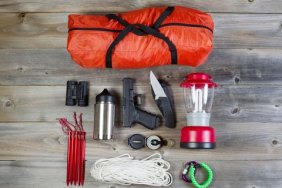 Hiking with a full pack can put a lot of strain on you. However, you can take measures to reduce this effect by utilizing trekking poles, evenly distributing the weight inside your pack to keep your balance and center of gravity low, and properly adjusting the straps and buckles on your pack to create the best fit possible. Each strap, clasp, and buckle needs to be tweaked to enable your pack to fit your body ideally, and today I’ve outlined the process for you.
Hiking with a full pack can put a lot of strain on you. However, you can take measures to reduce this effect by utilizing trekking poles, evenly distributing the weight inside your pack to keep your balance and center of gravity low, and properly adjusting the straps and buckles on your pack to create the best fit possible. Each strap, clasp, and buckle needs to be tweaked to enable your pack to fit your body ideally, and today I’ve outlined the process for you.
Whether you’re at home or an outdoor retail store, you can start adjusting a backpack’s fit by adding 10-15 pounds of weight to it to simulate a full pack. The end result is that the majority of the pack’s weight will rest on your hips. Start the process by making sure all the pack’s straps are loosened and unbuckled and stand in front of a mirror. Let’s begin with the hip belt. Put the pack on so that the hip belt rests just above your hip bones, then close and tighten the hip belt. Check the pads to make sure they fit comfortably around your hips, as this is where the pack’s weight will rest.
Next, the shoulder straps. Pull down and pack on the ends of the shoulder straps to tighten them. They need to be tight enough to fit securely and wrap around your shoulder so that they keep the backpack against your pack; they’re not designed to carry the weight. The anchor points should be roughly 1-inch below the top of your shoulders. You also have load lifter straps, which are located below the tops of your shoulders. These should be snug enough to pull weight off your shoulders put not too tight that they create space between your shoulders and the shoulder straps.
On most packs, there is a sternum strap that spans the distance between shoulder straps and fits across your chest. You’ll want to adjust this to a comfortable height and then tighten it so that the shoulder straps are away from your arms enough to allow you full mobility. Finally, there are stabilizer straps on either side of the hip belt that, when pulled snug, pull the entire pack body towards the hip belt. This will draw the weight towards the hips and help maintain balance. Make sure to do one final tweak of the straps to get the fit just right, especially focusing on taking a bit of tension off the shoulder straps so they’re not uncomfortably tight, and you should be all set.
Be sure to ask for assistance at the store if you have questions, as the associates will be willing to help you get the perfect fit. Properly adjusting your pack’s straps will prevent it from shifting too much during a hike, which—along with a well-balanced gear load—will keep your center of gravity and balance evenly distributed.








